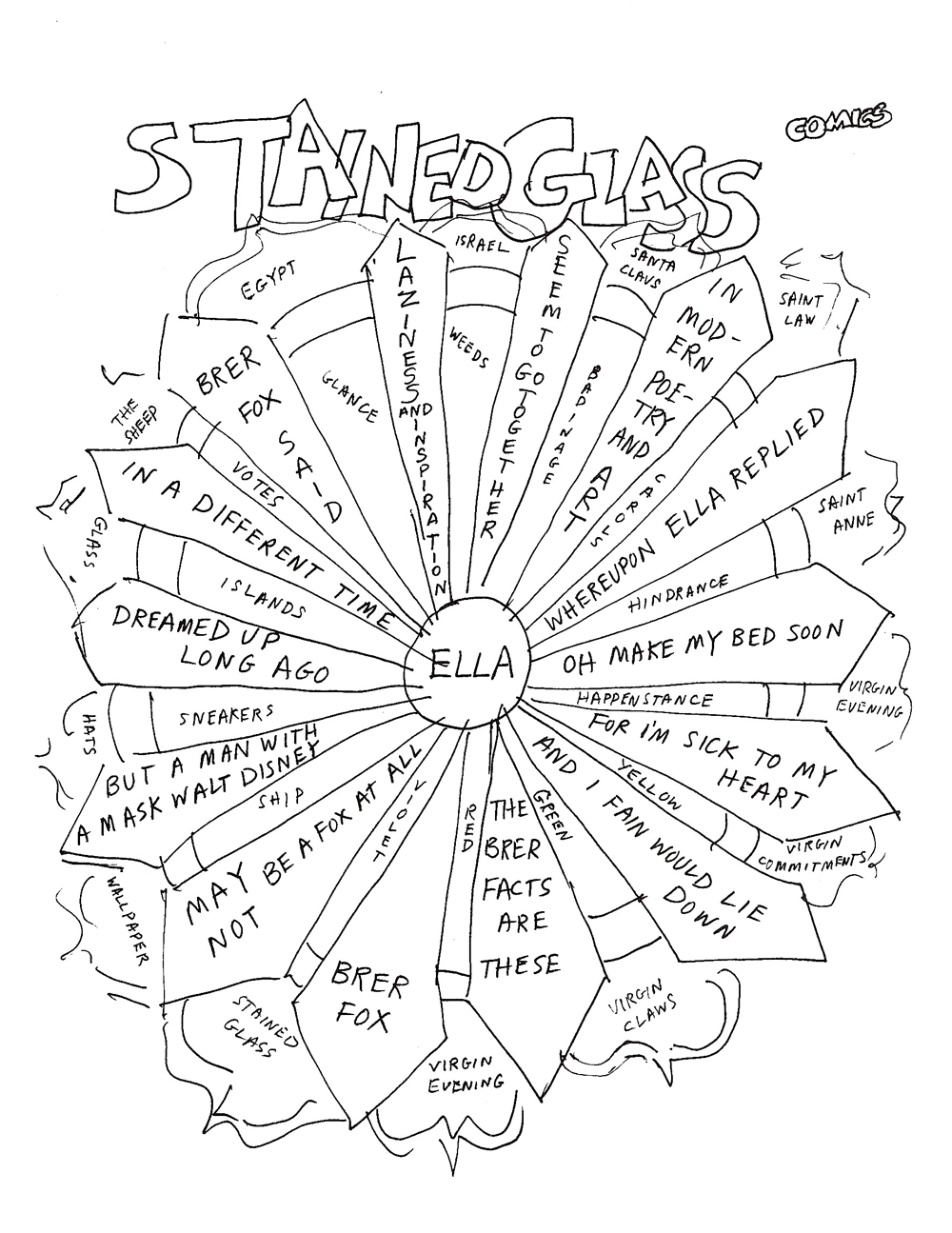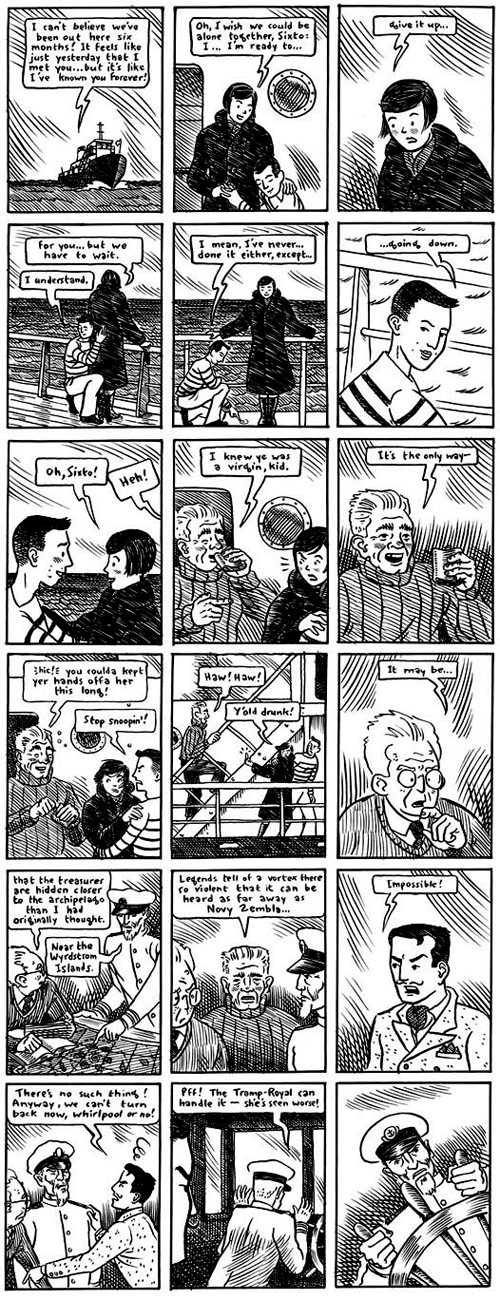As with poetry, segmented comics have the potential to accrue meaning simultaneously. This is especially true of comics poetry where visual-verbal non-sequiturs can be repeated as simultaneous moments rather than narrative panel sequences. Freed from linear narrative, a myriad of structural, formal and aesthetic choices enable audiences to interact with visual-verbal segments as simultaneous moments. Examples of simultaneity and multi-linear reading paths can be found in the collage, montage, cut-up and fragmented comics poetry of Joe Brainard, Kenneth Koch, Warren Craghead, Chris Ware, Farrell, Richard Hahn, Bianca Stone, Paul K. Tunis, Souther Salazar and anthologies such as Franklin Einspruch’s Comics as Poetry, Andrei Molotiu’s Abstract Comics and various Kramer’s Ergot editions. In these works, graphemes, gaps, images, lines, stanzas and silence spaces are layered and looped in ways that challenge sequential narrative readings. This is also true in the opening pages of Ray Fawkes’ ONE SOUL, where paint splotches are repeated in several panels to establish a poetic rhythm and sense of simultaneity. Spanning millennia and multiple dimensions, ONE SOUL entwines the conception, lives and deaths of 18 characters across time and space. Using poetic juxtaposition, repetition and enjambment the 18 panel spreads depict various incarnations of the same soul as infant, child, slave, warrior, lover, killer, parent, crone and spirit. This segmented simultaneity demonstrates the malleability of multi-linear and metatextual associations between visual-verbal components. Assessing where and how segmentivity is employed within the following examples enables a richer understanding of the experimental potential of comics poetry and alternatives to narrative analysis.

2004 | Kenneth Koch
Kenneth Koch’s The Art Of The Possible: Comics Mainly Without Pictures (2004), from which the title of this paper is borrowed, is a collection of poetry comics, written, illustrated and lettered by Koch. In the book’s introduction, David Lehman notes that for Koch,
the comic book, no less than the Elizabethan sonnet or the Romantic ode, has its place in the world of seriousness and can provide the fodder or the structure, the spirit or the form of a poem. The comic book panel was like the line in poetry, a unit of composition, suggesting “new ways of talking about things and dividing them up”1
Koch experimented with syntactical division by using comics devices such as handwritten typography, thought bubbles, panels and speech balloons. Throughout the collection, his use of segmentation and simultaneity replaces linear narrative hierarchy as seen in the hand-drawn grid of ‘BRER COMICS’ that encourages the poem to be read in multiple directions. The panels can be viewed left to right, up, down, diagonally or as equal components. For Lehman, this gives the poems a sense of jumping ‘from one plot to another.’2 ‘BRER COMICS’ doesn’t contain conventional images of characters in sequence, rather the panels frame words that reveal possibilities for simultaneous visual-verbal signification. Again, in ‘STAINED GLASS COMICS’, also featuring Brer Fox, this sense of simultaneity is heightened by the circular structure of panels. Division and organisation of the poem within a rounded window overturns linear sequencing as each segment can again be read in multiple directions. Non-linear arrangement of the poem warps and re-winds conventional narrative time while simultaneously heightening the aesthetic choices of Koch’s hand-sketched panels and typography.

Another creator of comics poetry to experiment with simultaneity is Warren Craghead. His seminal comics poetry collection, HOW TO BE EVERYWHERE (2007), takes its name from Apollinaire’s ‘insistence on the importance of “simultaneity” as a way of representing the way we experience the world’ – through uncertainty, spontaneity and chaos that cannot always be neatly sequenced.3 To realise simultaneity, Craghead reworked Apollinaire’s manuscripts into 50 new visual poems, combining syntactical experiments with visual-verbal comics devices such as speech balloons, captions, thought bubbles as well as spatial and typographic experimentation. There is no linear or sequential structure connecting the visual-verbal segments throughout the collection, instead each page is a self-contained poem often made of seemingly disconnected visual and verbal segments. Rather than traditional sequential panels, Craghead uses dotted strings and lines between images to draw the eye across, down and around the page in a way that encourages multi-linear ‘viewing’ of the poem.
Borrowing techniques from Apollinaire and the Cubists, Craghead creates diagrammatic pages that expose the multi-linear potential for both comics and poetry as seen in the poems ‘Harlequin’ and ‘They have hung Death’ where visual-verbal fragments are enjambed to create a countermeasured rhythm between segments. Additionally, Craghead creates poetic repetition by drawing the same figure from different perspectives. His erasure of sequential panels and frames further emphasises simultaneity as words and images bleed into the contemplative space of gutters rather than the straight lines of sequence. Through repetition and visual evocation, Craghead evokes the symbolist credo, viewing the poem as an aesthetic, material structure. In an interview with Tom Spurgeon, Craghead explains that his …
layered shapes, and the references to Cubist and related Modernist artwork in general, comes from Apollinaire’s deep interest and enthusiasm for that work. It also comes from my thoughts about how the lessons of Cubism can be applied to comics and narrative storytelling.4
These Modernist references are illustrated in Craghead’s use of fragmenting and half-finished images rather than completely captioned scenes. Departing further from traditional narrative sequence, Craghead’s sketches and stanzas are scattered across pages and left to linger in gutters, gaps and spaces. This spatial experimentation encourages audiences to connect several segments simultaneously in the process of ‘seeing’ rather than ‘reading’ the poem for narrative closure.


‘The Six Treasures Of The Spiral: A Comics Sestina’ | from, A Fine Mess, 2004 | Matt Madden
Also concerned with poetic adaptation and comics constraints is Oubapo member, Matt Madden. Creator of 99 Ways to Tell a Story: Exercises in Style (2005), a conceptual remake of Raymond Queneau’s Exercises in Style (1947), Madden’s comics experiment with a variety of non-narrative poetic techniques such a repetition, rhyming images, pantoum structures, palindromes, haiku and non-sequiturs. Amongst Madden’s poetic exercises is ‘The Six Treasures Of The Spiral: A Comics Sestina’ featured in the collection A Fine Mess #2 (2004). He describes this comic as an attempt to equate lines of the poem with tiers. Each page, then, functions like a stanza of a poem. Six panels feature a character from the crew about to set sail on a treasure hunt. The end panel of every line is repeated, changing order as do the final words in a six-line sestina stanza. The spiral of the sestina not only influences Madden’s structure but his argument for ‘form as content, and substance inseparable from style.’5 His numbered repetitions also link to the naming of the characters and reflect their position in the comic, ‘I named the characters and I coded that to their numbers one, two, three, four, five, six. So this guy’s named Einiger, German for one or the only, and this guy’s called Two Penny…Teresa and Forsyth’6 This sense of spiraling is again heightened by curlicues of drunkenness, confusion and swirling lines in the background. As the envoi draws closer, all six characters are sucked into a whirlpool of multiple meanings. Their final lines are the same as their first as each character realises they are sacrifices for the maelstrom.
- Lehman in Koch, Kenneth. The Art of The Possible: Comics Mainly Without Pictures. Canada: Soft Skull Press, 2004. p.5. ↩
- Lehman in Koch. 2004. p.8. ↩
- Craghead, Warren. HOW TO BE EVERYWHERE. Merryland: Gallery Neptune, 2007. p.5. ↩
- Spurgeon, Tom. ‘A Short Interview With Warren Craghead’. The Comics Reporter, September, 2007. ↩
- Madden, Matt. 99 Ways to Tell a Story: Exercises in Style. New York: Chamberlain Bros, 2005, p.1. ↩
- Madden in Bennett. Comics Poetry: Beyond Sequential Boundaries. 2012, p.177. ↩









